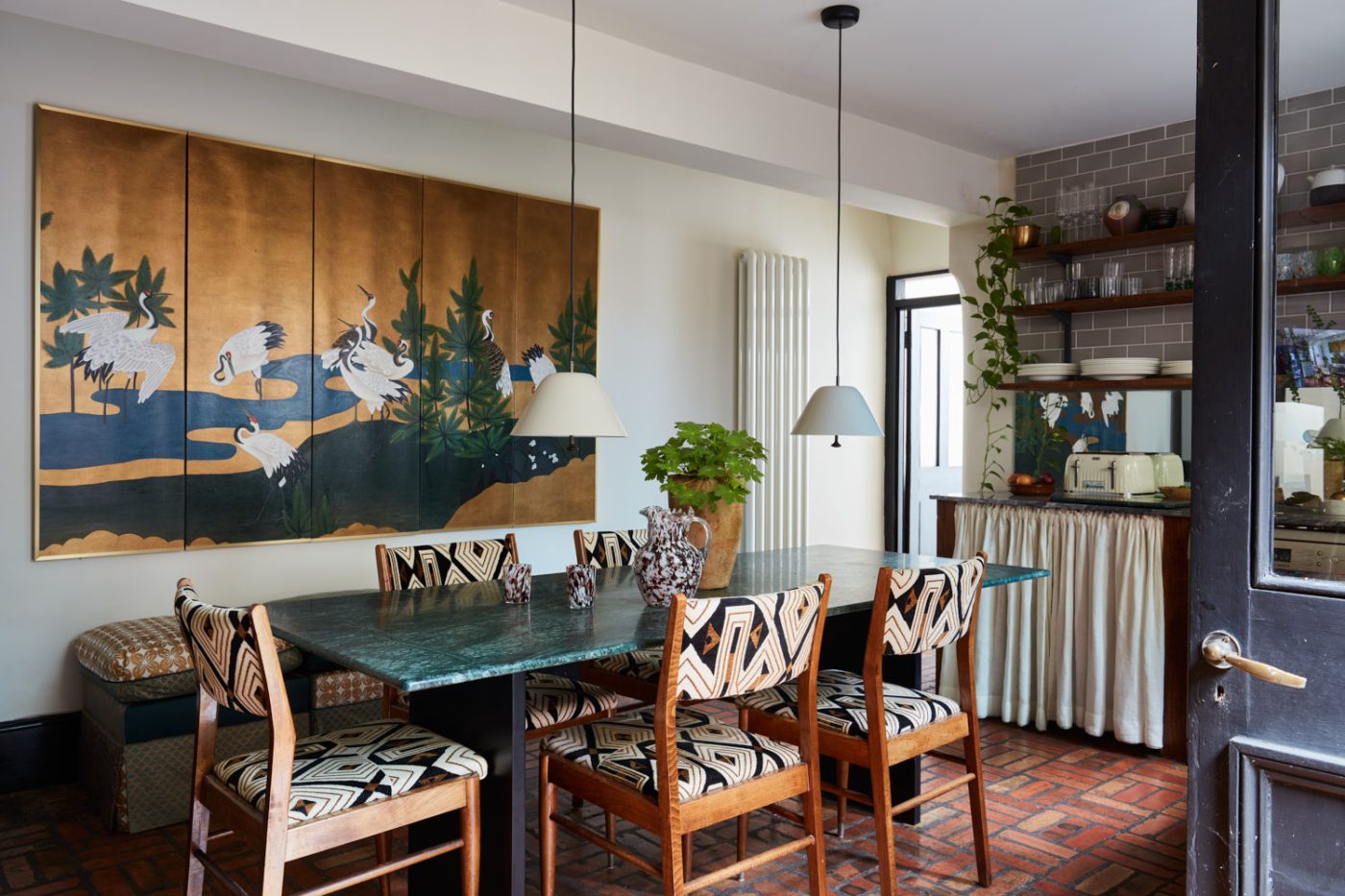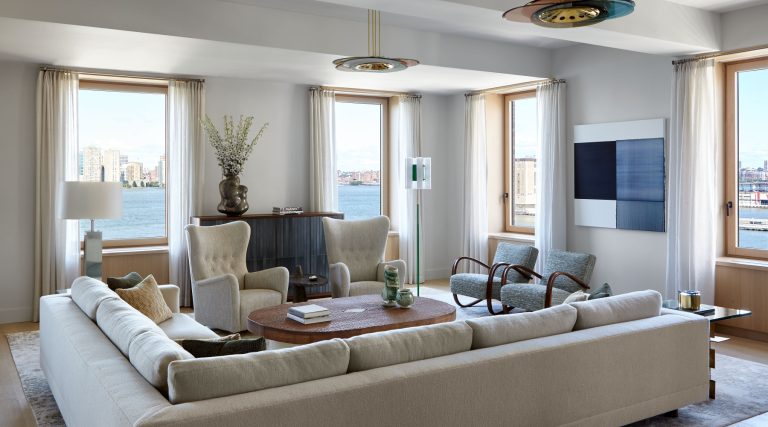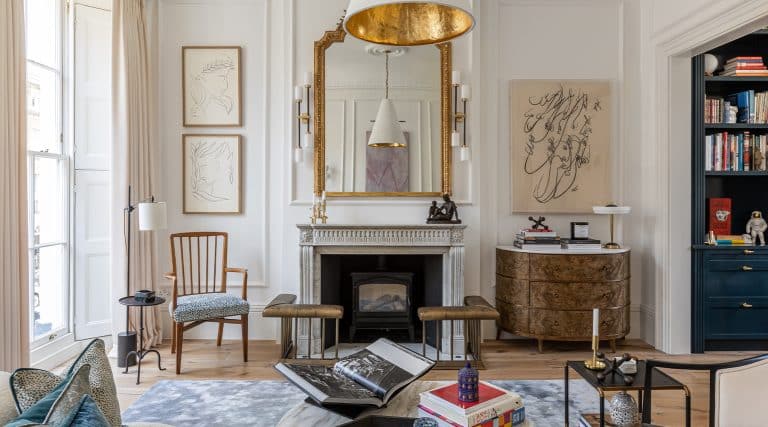September 1, 2024“Art is so important to me, because I feel like it holds the most power,” says London-based interior designer Sophie Ashby. “A room can be beautiful, comfortable and well-designed, but you can change the mood, and even how you feel when you’re in it, depending on the art.” Flick through her first book, a joyous tome titled Home, Art, Soul (Rizzoli), and that sentiment is abundantly clear in the dynamic schemes she and her team have masterminded for a roster of global clients over the past decade.

“I always try to start with art, because ideally, I don’t want to shift the balance of a room. If it’s brought in at the end, it can change the whole vibe,” she says. “I almost want people to walk in and think, ‘Wow, this is amazing,’ and then be drawn to that one piece that was where we started. For me personally, an artwork must have quite a lot going on for that to happen.”

A perfect example of her approach is a four-story villa in Kensington, West London, belonging to a 30-something art and design enthusiast who was already the proud owner of an abstract painting by British artist Howard Hodgkin. “He had two or three key pieces, so it was about building out his collection,” says Ashby. To sit alongside the black-and-white Hodgkin, she selected an expansive oil painting by Ethiopian artist Tesfaye Urgessa, whose dramatic, painterly style is influenced by Ethiopian iconography as well as German neo-Expressionism and the School of London, which he encountered during travels around Europe. “I found the painting very early on in the design process, and everything unfurled from there. The sense of color is amazing, and in fact, it gave us our whole palette,” Ashby says. “Tesfaye is one of my favorite artists — he’s up there with the greats. This is an incredible, world-class painting with so much strength, and there’s more to see every time you look.”

Emotive art can also be found in the kitchen, where a figurative piece by South African artist Mia Chaplin, sourced by Ashby, hangs above the sink. An unexpected addition in the predominantly functional space, the painting, along with a collection of ceramic and glass vessels, adds a touch of softness to the somewhat masculine scheme. “I adore the fact that it’s nudes, which is something you imagine might not work in a kitchen. Things are leaning, things are hanging — I like the casualness of the composition.”

In a theatrical project in Central London, christened the Belgravia Jewel Box by the Studio Ashby team, the living room, lined in a creamy silk wallpaper, is home to a plethora of works, most of which were already owned by the stylish French client. “The homeowner is a passionate collector with a very distinct eye and, as a result, has the most extraordinary collection,” says Ashby. “Here, I helped her with one or two pieces, including the portrait above the fireplace, which is by Dutch artist Peggy Kuiper. We sourced this painting as it was so strong and it set the tone for the space. I find this kind of portraiture works particularly well in a living room, where people might spend a significant amount of time, as there is something to be revealed with each look.”
When it comes to marrying furniture with art, the key, she says, is to create an eclectic mix. “In simple terms that means sitting very different things next to one another. So, if we bought a contemporary portrait like this, we’d pair it with a Louis XV console or an Empire chest of drawers, then maybe add a handmade mid-century table lamp. I’m always looking for a composition to fuse complementary opposites.”
Among the artworks in the room is the Yves Klein Blue Venus sculpture that sits proudly on a plinth. “It’s a very harmonious space and the colors all tie in beautifully together, but this pop is what makes the magic happen,” she explains. “These unexpected elements make everything come alive.”

Another standout addition is a figurative painting by German-born artist Delia Hamer, which hangs in the turquoise-stippled entryway. “This is a beautiful prelude to some of the objects throughout the apartment,” she says. “The distinctive sun motif echoes the Sister by Studio Ashby sunburst ceiling light that illuminates the hallway, and the urn recalls the beautiful ceramic pot that we placed below. I love an ornate frame, but it has to be with the right piece, and it’s usually quite difficult to fuse with contemporary work. This painting has a touch of gold in it, so the traditional gilt is absolutely perfect. It also echoes the bronze sculpture and mirrors on the adjacent wall, which brings the scheme together.”


In the primary bedroom, a pair of delicate figurative paintings are mounted on the front of the bespoke shelving. “It creates depth,” Ashby explains, “and with just a couple hooks, you can easily swap things around — I like that casual flexibility.” Hanging works at eye level is something she champions. “It’s considered low as far as professional art hangers go. I often have a little wrestle with them when they want things higher. But I feel if you can’t look straight into the middle of a piece, it’s not in the right place.”
Tucked down a street off East London’s Brick Lane, Ashby’s own home — which she shares with her husband, fashion designer Charlie Casely-Hayford; stepdaughter, Rainbow; daughter, Gaia; and son, Skyler — is a characterful mix of antique, vintage and contemporary furniture and lighting. And, of course, uplifting art.

To fill the walls of the living room, the designer purchased two vast Color-Field paintings by Australian artist Heath Wae, whose work was recently exhibited at the Studio Ashby showroom. “I’ve long enjoyed his meditative pieces,” she says. “I felt the warm shades would counteract the west-facing darkness of the room, and the gentle luminosity lends such an inviting feel, particularly in the evenings.” The paintings go particularly well with the bespoke citron sofa, upholstered in a Pierre Frey fabric, and the Sister by Studio Ashby patchwork rug.

Ashby recommends choosing art of maximum dimensions. “In general, I opt for things that are large scale, and I think that’s where a lot of people fall down,” she explains. “They buy a lot of small or medium artworks, which on a big wall don’t pack that much punch.” The only exception is in a hallway or a corridor where it’s not possible to step back far enough to see a large piece. “That’s where a gallery hang with smaller works can work well. Equally, if you’re looking to place art above a bed, something large may end up too high on the wall. In that scenario, think about pushing two smaller pieces off to the side. In the middle they could look lost, so asymmetry can be the answer.”
In the vibrant library, which Ashby says sums up her personal style, South African artist Anico Mostert’s figurative painting Next Door Neighbours was the starting point for the scheme. “Her paintings speak to the quiet in-between moments of everyday life. The object-less space she depicts is such an unexpected pairing with the library itself. I like how it’s naive in some ways but the strength of the flat background color and the composition are so captivating. Once it was in position, the room unfolded around it.”

Expanding what is traditionally thought of as art, a hand-painted Japanese mural by de Gournay is mounted in the kitchen above the marble-topped table. “It’s a great space, but the materials are quite dark and heavy and there’s not much natural light,” Ashby says. “I’ve always loved Japanese screens, so I spoke to de Gournay, and we came up with this together. The gold ground of the piece gives the room a wonderful glow.”
Her number-one piece of advice when it comes to choosing art is to not take the process too seriously. “So many people live with very little or even no art, as buying works can be overwhelming and intimidating. But the only thing you need to think about is, Does the art move you? Does it make you feel something? If it evokes a reaction, that’s good. Sometimes, I find myself buying really valuable, important works for my clients and it’s purely because I love them. If that translates into a good investment, then it’s a happy bonus. Just follow your instincts and choose something you know you’ll treasure forever.”



